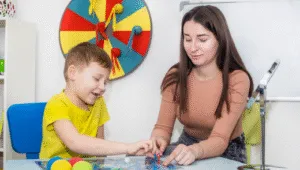OT help with Sensory Processing Disorder (SPD) may make daily living difficult for a child. It alters how the brain processes sensory information; thus, the child is either overreacting or underreacting to situations such as sound, touch, taste, sight, smell, and movement. Occupational therapy helps with sensory processing disorder and offers a complete way to manage the symptoms and improve a child’s daily life. The present article describes what SPD is, what types, symptoms, causes, and why occupational therapy is an important factor of treatment, and more.
What Is Sensory Processing Disorder?
Sensory Processing Disorder (SPD) refers to a disorder that affects how the brain processes sensory information. Part of the SPD is that some children are over-stimulated by sound, touch, sight, smell, etc, or seek additional stimulation. It is due to the reason that basic situations seem difficult to them, and they might find it hard to behave or respond to the world as other children. Treatment of the sensory processing disorder through occupational therapy assists the children in handling their senses and responding more appropriately to the surrounding environment.

Types of Sensory Processing Disorder
There are different types of OT help with sensory processing disorder, each affecting a child’s sensory experiences in unique ways. The main categories include:
1-Sensory Modulation Disorder
This is where a child is unable to control his reaction to sensory stimulation. They can either be hypersensitive (acting too much) or hyposensitive (not acting enough) to anything they feel. As an example, a hyper-sensitive child will be upset by loud sounds, and on the other hand hyposensitive child does not respond to a strong smell.
2-Sensory Discrimination Disorder
Kids with this condition cannot easily separate various senses. e.g., they might not be able to distinguish between the textures or sounds, or temperature, giving them difficulties in their daily activities.
3-The Sensory-Based Motor Disorder
This is the kind of OT help with sensory processing disorder, which contemplates coordination and movement inabilities because of the sensory processing problems. The children may misalign fine motor tasks or may also have problems with stability, as well as land orientation.

Symptoms of Sensory Processing Disorder
Symptoms of OT help with sensory processing disorder differ greatly between individuals, and some of the general indications consist of:
- Hypersensitivity: Excessive response to the sensory information, e.g., ignoring pain, lack of reaction to loud noise.
- Motor hardship with Craze: Problems with physical actions such as running, writing, or shoelace-tying.
- Emotional Responses: Battering down of emotions or meltdowns over the sensory stimuli.
- Social Challenges: Difficulties relating to peers as a result of augmented sensory sensitivities or complications with motor skills.
Causes of Sensory Processing Disorder
Although it is not known precisely what causes OT help with sensory processing disorder, it is thought that a combination of genetic and environmental factors might be involved. Its possible factors are:
- Genetic Factors: SPD might have a familial nature, which implies a genetic basis.
- Premature Birth: SPD is more likely in children born before the term.
- Trauma or injury: Trauma or injury may also lead to the development of sensory issues.
- Autism Spectrum Disorder: SPD is a common issue for many children with autism, but it is not the same as autism.

How Occupational Therapy Helps with Sensory Processing Disorder
OT help with Sensory processing disorder can be handled with the help of occupational therapy; it is one of the most efficient methods of handling the symptoms of SPD. Occupational therapists (OTs) treat children in order to enhance their sensory-processing skills and the capacity to respond accordingly. The main focus of treatment is to enable children to perform better in their day-to-day affairs, either in the home setup or in classrooms, or on various social platforms.
1-Sensory Integration Therapy
This therapy is all about gradually exposing the senses and doing it under control. The therapist may engage toys such as swinging, jumping, or using textures to make the child adapt to the stimulus. The aim is to make the brain reorganize the manner in which it interprets information on the senses, and this would help the child adapt better so that they react according to what is necessary.
2-Sensory Diets
A sensory diet is an individualized guide to give the appropriate level of sensations during the day. It may consist of such activities as deep pressure touch, stretching, or some calm-down routine that will keep the child regulated and focused.
3-Fine and Gross Motor Skills Education
Children with OT help with sensory processing disorder usually have an issue with motor skills. It is possible to deal with the assistance of an occupational therapist and persistence on such fundamental abilities as hand-eye coordination, balancing, and dexterity. Drawing, building blocks, and motor activities are some of those activities that can develop these skills. This is particularly relevant when autism affects motor skill development, as targeted interventions can significantly improve functional abilities.
4-Environmental Modifications
OT help with sensory processing disorder can also provide recommendations to the child, such as modifying his/her environment so that it can be friendlier sensory-wise. This may involve turning off the lights, wearing noise-canceling headsets, or giving the child fidget toys that can help the child.
Occupational Therapy Checklist: Does My Child Need Therapy?
Have you ever wondered if your child would be helped with an occupational therapy checklist due to sensory processing disorder? Here is a short checklist on whether to get such assistance:
- Does your child have overreactions to some sounds, textures, or foods?
- Does your child avoid socializing in the name of being uncomfortable to the senses?
- Does your kid fall or have problems with motor competence?
- Does your child have concentration or completion problems at school?
- Does your child blow up often or have emotional outbursts?
In case your answer to any of these questions is yes, then it could be time you seek the assistance of an occupational therapist to evaluate.
Treatment Options for Sensory Processing Disorder
While OT help with sensory processing disorder is the primary treatment approach, other strategies may be used in conjunction with therapy:
1-Behavioral Therapy
One can learn how to deal with his or her response to such sensory material through behavioral interventions among children. This may entail the issuance of rewards or positive reinforcement, which motivate adaptive behaviors.
2-Parent and Teacher Assistance
Parents and teachers may be of utmost importance in helping children with SPD. This can be a game-changer by engaging them and educating them on the condition and offering them tools that would enable them to keep the child regulated in various settings.
3-Medication
Although medication is not usually employed in primary treatment, a related condition may be managed with the help of this medication, e.g., SPD can be accompanied by anxiety or ADHD, and medication can help in such a case.

Understanding the Connection Between Sensory Processing and Behavior
OT help with sensory processing disorder. The sensory problem may have an important impact on the behavior of a child. Experiencing sensory input, children with SPD are not capable of responding to the sensory experience properly at all times. This brings about behavioral difficulties.
The occupational therapy to address sensory processing disorder provides the means to help the children with such behaviors to control them and hence, the reactions towards the sensory stimulus in a better manner. To illustrate, a hyperactive child may become temperamental or withdrawn at the instance of loud sounds. During treatment, the child will know how to suppress these responses, and it will be simpler to communicate with the environment as well as with people.
Everyday Functioning for Children with SPD
OT help with sensory processing disorder is designed to improve a child’s ability to function in daily life. Children with SPD find it difficult to perform their daily activities like dressing, eating, and spending their time with other people. It is done through therapy by exposing their senses slowly and teaching them self-control. When they train, they develop strengths that simplify everyday life. Physiotherapists have an opportunity to communicate with teachers and create an individual plan for the child that could include the use of sensory material or taking breaks when it is necessary.

Creating a Sensory-Friendly Home Environment
It is relevant to make a home a sensory-friendly place for children with sensory processing disorder (SPD). Sensory overload can be explained as a case where the senses receive too much information, that the individual feeling overwhelmed. The parents can avoid this by sound damping: lower the light, reduce loud noise, and make quiet areas where the child can retreat. This activity each day makes the child get the feeling of security and relaxed at home and contributes to the child’s OT therapy to help with sensory processing disorder.
What to Expect During Occupational Therapy Sessions
During OT help with sensory processing disorder, children engage in structured sessions designed to improve sensory regulation. The typical way around a special need situation is where a therapist first learns about the special need of the child by assessing him well first. During treatment, the therapist selects those activities, like swinging, jumping, or touch play, that are appropriate to the sensitivities of the child.
Over time, the sessions are changed to the enhancement of coordination, attention, and motor skills. The parents also learn how to maintain the work at home so that the child can exercise those skills at home without therapy. Determining whether a child could benefit from occupational therapy requires careful observation of their daily functioning and developmental progress.
The Role of Play in Occupational Therapy for Sensory Processing Disorder
OT help with sensory processing disorder often incorporates play as a core therapeutic tool. Sensory play is also enjoyable owing to the fact that it invokes the utilization of all five senses, and sensory play enables children to learn how to interpret various sensory messages. Working on the textures of the toys, swinging, and playing with musical instruments will provide the children with SPD with the opportunity to work on their reaction and develop response control. Sensory-friendly therapy allows children to adapt to stimuli and develop important skills through play.
How Early Intervention Can Improve Outcomes for Children with SPD
Early treatment is critical to the success of an individual with sensory processing disorder (SPD). The earlier a child goes into therapy, the better. The first work can enhance sensory control and general functioning. The onset of therapy works out early to reduce the overall impact of SPD on the life of a child. This activity provides children with aids to managing sensory stimulation, builds motor control, as well as promotes positive interactions with the environment. Initiating treatment at an early age forms a good foundation for the future development and social life of a child.

OT Affects School Performance in Children with SPD
Specific challenges that children with SPD usually have at school are the inability to focus, to coordinate movements, and to control sensory information. Occupational therapy helps with sensory processing disorder and is vital in supporting children’s academic success. During therapy, the children are taught the strategies of being focused, able to organize work, and dealing with distractions by the senses in the classroom. The therapists can liaise with the teacher and come up with an individualized plan for the child that may include using material with sensory contents or having breaks as required.
Collaborative Approaches: How Parents, Teachers, and Therapists Work Together
When it comes to OT help with sensory processing disorder, collaboration between parents, teachers, and therapists is essential. The responsibility of every party to the child is to meet the sensory needs of the child. Parents play an important role in supporting therapy at home with the help of such interventions as sensory diets and changing the environment. Such collaboration between parents, teachers, and therapists enables the various needs of the child to be addressed in different settings, and the child has a cohesive support system that makes the child a success.

Challenges in Treating Sensory Processing Disorder
Managing sensory processing disorder proves difficult, with the condition being unique to each person. The sense abilities and sensitivities vary in each child and will have to be approached on an individual basis.. However, OT help with sensory processing disorder and emphasizes persistence and flexibility. Therapists keep on modifying their strategy depending on the development of the child. These troubles can be addressed by parents and therapists keeping their composure and acting regularly, improving the child gradually.
Success Stories: Real-Life Examples Who Thrived with Therapy
Many children with sensory processing disorder have achieved significant progress through OT help with sensory processing disorder. As an example, a child who was highly hypersensitive to the texture and sound could participate in group activities and school events following regular treatment. And another child with poor coordination learned to improve motor ability and started attending sports activities. These case success stories are clear evidence of how powerful a therapy can be when implementing it in dealing with SPD, and how these children can be taught to live in harmony with their own sensory demands.
FAQs
Q1: How does one begin the occupational therapy of SPD?
This is usually preceded by an occupational therapist’s assessment of the sensory needs of the child. This can consist of monitoring how the child reacts to different senses and conversing with the parents about any issues.
Q2: What is occupational therapy for SPD?
The duration of treatment is dependent upon the needs of the child. It may take a few months before some of the children experience major improvement, and for some children, it may take years before they can get better.
Q3. Is it possible that SPD becomes better with time?
Having had early intervention and proper treatment, several children with SPD are actually able to get better with time. Nevertheless, some can still require assistance even at later stages.
Q4: Is it possible to diagnose sensory processing problems?
Indeed, an occupational therapist can diagnose and assess problems with sensory processing, in relation to the child’s behavior and sensory reactions.
Q5: Is autism associated with SPD?
Is this true? Sure, the difficulty in processing sensory information is also common among children with autism. It is also possible that SPD can take place in children without autism.
Summary:
OT help with sensory processing disorder gives the much-needed relief to the child who has sensory problems. With the help of specific therapeutic strategies, children can be exposed to the specific procedures of sensory regulation and the development of motility activities, and they can be successful in everyday living. In case you think that your child might be struggling with SPD, the first step towards a much richer and well-balanced life can be to ask an occupational therapist to assist you. Through proper tools and approaches, children having SPD can deal with the difficulties and achieve maximum potential.
